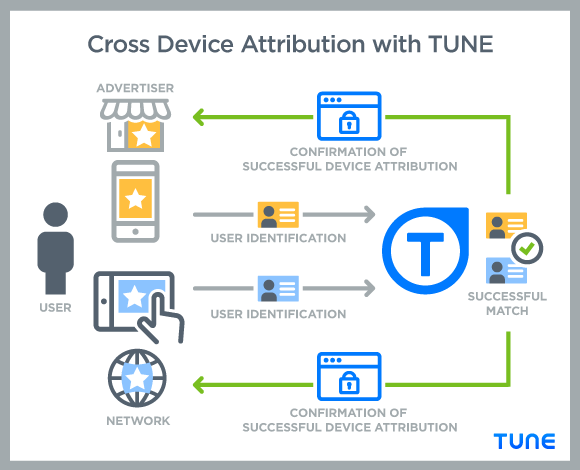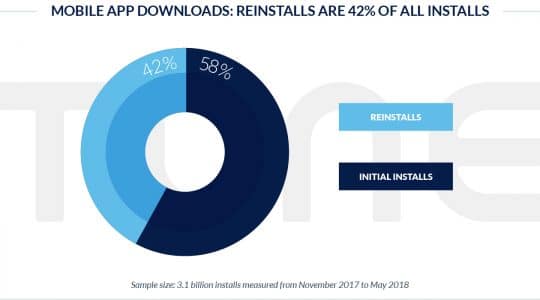
What device do you use for reading the news? What about shopping, watching a TV show, or playing a game? For many people, the answers may differ for each of these questions.
Sometimes, the answer is whichever device is nearby – I read the news on my phone while I’m on the bus, but I read it on a laptop when I’m checking my email or writing a blog post.
Sometimes the answer is based on a simple preference – I like the larger pictures and widgets that come with shopping on a tablet, but I get tired of holding a tablet while I’m playing a game.
To be effective, advertisers need to reach people where they are.
Imagine a situation in which I’m on my tablet, and an advertiser shows me an ad for my favorite boy band. I’d really rather get the music on my phone instead of my tablet, so I grab my phone and download the music.
The advertiser would like to know that the download on my phone was motivated by the ad I saw on my tablet, because like everyone else, advertisers want to see value from the money they’re spending. Reciprocally, the ad network would like to know whether their ad slots provide value to advertisers.
I might have an interest in this, too – maybe the ad on my tablet offered a discount on the new album. Can I go to the advertised site on my phone, download my favorite music, and still get the offered discount? This is the essential problem of cross-device attribution, knowing that an action I take on one device (downloading an album on my phone) was driven by something that happened on a different device (viewing an ad for that album on my tablet).
Can the advertising ecosystem accomplish cross-device attribution, providing value to advertisers, ad networks, and even users, all while still protecting consumer privacy?
At TUNE, we have been thinking about these important questions. We provide cross-device attribution when both the ad network (who showed the ad) and the advertiser (who paid for the ad) have a pre-existing relationship with the user. We believe this strikes a balance, providing valuable insight to both advertisers and ad networks, while not leaking user-specific information and personal data from one party to another.
How does TUNE address the cross-device attribution problem?
When the ad is presented to the user, the ad network gives TUNE whatever information they have about the user, like the hash of an email address or a phone number. (As a rule, we hash all email addresses, usernames, phone numbers or any other “personal data” we receive. Visit our support documentation for more information.)
When the user takes an action which may have been based on an ad, the advertiser sends TUNE whatever information they have on that same user. If the information provided by the advertiser matches the information provided to TUNE, verifying that it’s the same user, we inform both the advertiser and the ad network that cross-device attribution was successful. If TUNE is unable to verify it’s the same user, then we won’t provide any information to either party.

In the example I describe above, maybe I was logged into the shopping app on my tablet, and then I signed into a music service on my phone using the same email address. When I added the album to my shopping cart, the music service checked with TUNE and found that I had recently seen an ad for that album, so it provided me with the promised discount.
For larger companies, this can be even easier and more secure for all parties. If I was shopping for a Bluetooth speaker with the same company as the one selling the album, they would know my account ID or username and could perform cross-device attribution with TUNE using those identifiers.
Responsible cross-device practices are a win-win for everyone.
TUNE’s approach to cross-device attribution provides some important assurances. Most importantly, the end user knows that personal data provided to an advertiser hasn’t been shared without the user’s knowledge. The advertiser should already have provided notice to the end user and obtained their consent to share this information with TUNE. (Note: TUNE contractually requires our advertiser clients to provide and obtain legally requisite notice and consent for all end-user data collection.) TUNE’s data pledge provides our clients additional assurances, as we only process data on instruction by our advertiser clients; we do not repurpose or resell data, and we do not share data without our clients’ permission.
Cross-device attribution may seem complicated, and there are certainly important data aspects to consider, but the way we do it at TUNE is simple and privacy-friendly. We view it as the best possible scenario – a win-win-win for advertisers, ad networks, and consumers.
Author
Becky is the Senior Content Marketing Manager at TUNE. Before TUNE, she led a variety of marketing and communications projects at San Francisco startups. Becky received her bachelor's degree in English from Wake Forest University. After living nearly a decade in San Francisco and Seattle, she has returned to her home of Charleston, SC, where you can find her enjoying the sun and salt water with her family.



Getting insights into cross-device attribution is hugely important! You summed it up perfectly in that last line, it’s a win-win-win for advertisers, ad networks, and consumers. Coming at it from a marketing perspective, it’s really valuable to know if an ad that you are running on a tablet or even desktop actually leads to a download on a phone. This can help inform where you run your ads, what type of ads you run, and the actual ads themselves. I’ll be curious to see how cross-device attribution will change in the coming years. It seems like phones keep getting bigger and tablets keep getting smaller. I don’t see cross-device attribution becoming any less important, but it will be interesting to see how it evolves.